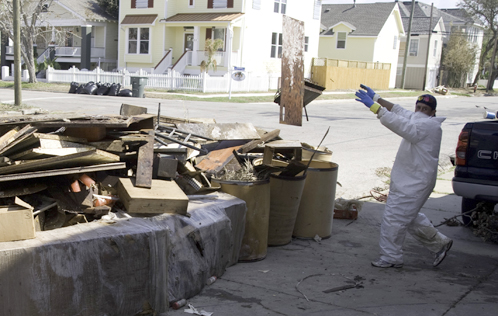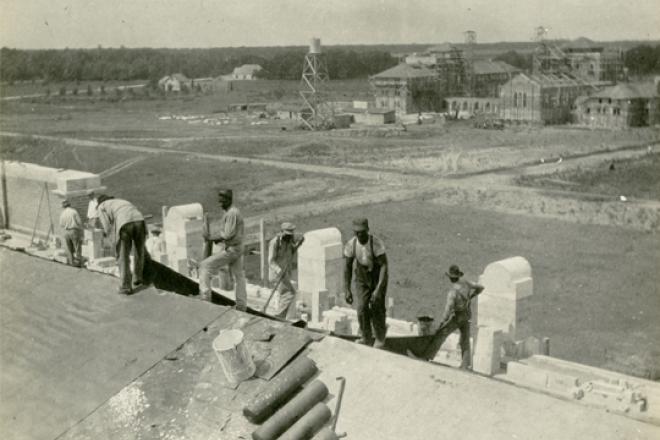
Man throwing debris into pile in Galveston. [Photo by Eric Hester]
What happens when you take a failing affordable housing policy and add a direct hit by Hurricane Ike? I talked to Chula Sanchez, a LEED-certified architect and member of the Galveston Planning Commission, about just that.
"The planning commission seems to be more of a permitting commission," Ms. Sanchez explained.
"Our job will become more important as time goes on. The General Land Office (GLO) has drawn a new line in the sand four-and-half feet above sea level. People can stabilize their properties on the beach but we cannot issue new construction certificates in that zone. The line is normally based on vegetation but the storm wiped that out and the new line is based on mean sea levels. Drawing that line, many houses have ended up on public property."
Away from the beach, the picture is at least as troubling, especially for lower-income people. "All of our housing projects have been closed," she said. "They are gated and closed. All of those inhabitants have had to look somewhere else." In the current issue of Cite magazine (no. 76), Susan Rogers writes about the national strategy to provide affordable housing, which is to promote home ownership. She argues that a large proportion of the population cannot afford ownership, even with subsidies. One in five Houston families cannot afford fair market rent for a two-bedroom apartment (according to the Low Income Housing Coalition). Understood in that context, the closing of public housing in Galveston is an effect of the hurricane, but the failure to work towards reopening them is consistent with national trends and the example of New Orleans after Katrina.
"The flooding issue happened all over town. Poor people, rich people," Sanchez said, but she quickly pointed out that the part of town east of English Bayou, called the Denver re-survey area, where many low-income and minority people live, was very badly affected. "I go week to week to these neighborhoods. Every week there are five houses wiped off. People are collecting their insurance if they are lucky enough to have it and selling their property for a song. That could be a good thing if developers build something that is affordable. But where are those people going now?"

The Texas Observer covered the problem well in a recent article, The Castaways: Can Galveston's black community survive the island's comeback?
The north and south sides are roughly divided by Broadway Street, the island’s main east-west thoroughfare. During the Jim Crow era, Galveston’s white leadership made a push to uproot blacks from historically integrated neighborhoods and concentrate them in a ghetto north of Broadway. The result was the poorest and most crime-plagued part of the island. But also one of the proudest and stubbornest.
Hurricane Ike damaged about 75 percent of Galveston’s homes. But the storm wreaked extra havoc on North Side neighborhoods. Water surged from Galveston Bay into the low-lying area, flooding homes that were built decades ago under lax building codes. Meanwhile, luxury houses, many sitting practically on the beach, weathered the storm virtually unscathed...
On the North Side, four of six housing projects are filled with mud and mold, fenced in and condemned by the Galveston Housing Authority. Many of their residents are now stranded in a diaspora that includes San Antonio, Austin, Houston and Texas City. Others sleep in cars, on the beach or, until recently, in two tent cities that sprang up before FEMA brought in trailers.
This is all bleak news, but Sanchez told me that she had made a pledge to herself "to be positive." She said, "I know I can do one house. I can help one family get one house to code." That family is the Garcias. This Christian Science Monitor piece covers the effort to help the family, which is currently living inside a garage, Hit by hurricane Ike and unexpected layoffs, Galveston ponders its recovery:
"This is an opportunity to build smart and plan smart," says Sanchez, a local design professional and member of the Galveston Planning Commission.
She'd like to see houses like the Garcias' rebuilt according to new codes, possibly elevated to help avoid future flooding, or even completely razed and replaced with sustainable and green housing.
Sanchez notes that she has good support from other architects including Cite editorial committee members, Susan Rogers and Rafael Longoria. Barrie Scardino and the AIA Disaster Recovery Action Director, Antoine Bryant, have coordinated an effort to provide volunteer assessments.
Sometimes, though, it is difficult to connect people with the necessary help. "I called a woman I know," Sanchez told me. "She doesn't speak English. She's a ghost figure. She's sixty-years-old. Born in the US at home but her parents did not do the paperwork. She's watching her contractors put in the walls without any insulation. Is there someone who can help this person? The Salvation Army can't take people in. The hotels are full of adjusters, FEMA people, and contractors. This woman wants to stay under the radar. She was born here but doesn't have any papers. Her son was recently deported though he went to Ball High."

Photos by Eric Hester
Again, focusing on the positive, Sanchez attended the long-term recovery meeting two night ago. "We had our first public meeting," she said. "It was open to the public to formulate a plan for the council to vote on in 90 days and was facilitated by FEMA. It is a good beginning. We have had a lot of hot-button issues in the last two years. Ike brings them all to the front-burner. Housing, jobs, the environment. There are those who don't want any development and those who want unbridled development. I am in the middle, for sustainable development. I think high-speed rail from Galveston to Houston would be the boon of all times."
Other good reading:
A Tale of Two Storms: Galveston’s Seawall Became Its Maginot Line by Tom Curtis, who wrote a similar article but in speculative form for Cite's hurricane issue.
Galveston council takes stand on housing: Resolution urges feds to speed up the rebuilding of low-income units [Houston Chronicle] by Harvey Rice. This brief report gives you a sense of the political struggle on the island.











